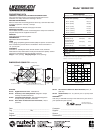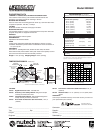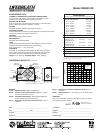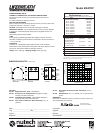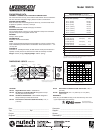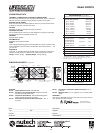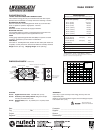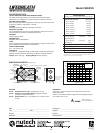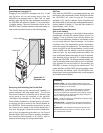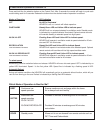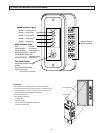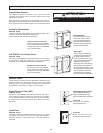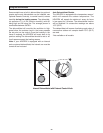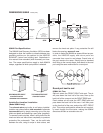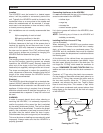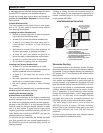
16
Operating the ControlAir 15
Plugging in the HRV/ERV energizes the unit. A self
test function will be performed every time the
HRV/ERV is energized (refer to “Self Test” for more
details). After the self test has completed successfully
the HRV/ERV will default to Speed 1. This is the facto-
ry default setting. Follow the instructions found on the
HRV/ERV door to select desired mode and speed, or
refer to the instructions found on the following page.
Removing and relocating the Control Pad
The Control Pad can be removed and installed in a
remote location (100’ wire length max). The Control
Pad can be installed in a 2x4 box with a “Decora” type
cover plate or can be installed in the optional
“Ventilation Dehumidistat” or “Air Sentry”. When the
Control Pad is installed in a remote location, all option-
al controls will still be wired to the Control Module on
the HRV/ERV. When remotely mounted on its own,
the Control Pad is wired to the Control Module by 3
wire (min. 20 gauge). Connect the colour coded termi-
nals to the corresponding terminals on the Control
Module. When the Control Pad is remotely mounted in
the Ventilation Dehumidistat or Air Sentry, refer to
optional controls page for wiring requirements.
Self Test
Each time the
HRV/ERV
is powered/energized the self
test function will automatically initiate. During the self test
the
HRV/ERV
will cycle through all the speeds
available (1-5), test the damper motor operation and
will default back to the previous mode/speed selection,
(factory default is Speed 1). Total self test duration is
approximately 1 min. 30 sec.
Automatic Defrost Operation
(Not on all models)
The advanced technology of the digital microprocessor
automatically activates the defrost system only as it is
needed. To be an efficient heat recovery device, the
HRV/ERV must effectively provide for core defrost as well
as providing efficient heat exchange. As outdoor
conditions cool, the temperature sensor (thermistor)
tracks the supply air temperature. The thermistor then
sends its signal to the microprocessor (circuit board)
which initiates only the defrost cycle time required to
clear the core. On recirculating defrost models, the
core is defrosted when the supply air port is automati-
cally blocked off and exhaust air is redirected back
through the HRV/ERV. On damper defrost models, the
core is defrosted when the supply air port is automati-
cally blocked off and the warm air surrounding the
HRV/ERV is drawn in through the defrost port. The
mode indicator will flash RED during the defrost cycle.
By optimizing the defrost cycle, the HRV/ERV com-
bines money saving performance with a well designed
and reliable control system.
Glossary
DEFROST MODE - to ensure reliable operation during cold
weather, the HRV/ERV will automatically cycle through its defrost
mode as needed. (not on all models)
DEHUMIDISTAT - a control device that senses the amount of
moisture in the air and will activate high speed fan operation
when the air moisture level exceeds the control setting. The opti-
mum air moisture level (or relative humidity [Rh]) in the typical
home is in the range of 30 to 50% Rh.
RESET - whenever resetting of the HRV/ERV is required, simply
disconnect power for 30 seconds.
STANDBY MODE - the HRV/ERV is energized and waiting for
fan operation to be initiated by a remote device or manual over-
ride.
THERMISTOR
- the
HRV/ERV
's temperature sensor which
measures electrical resistance in a known manner, as out-
door temperatures fluctuate.
ControlAir 15
Exploded view
Control Module
Control Pad
Function and Controls



